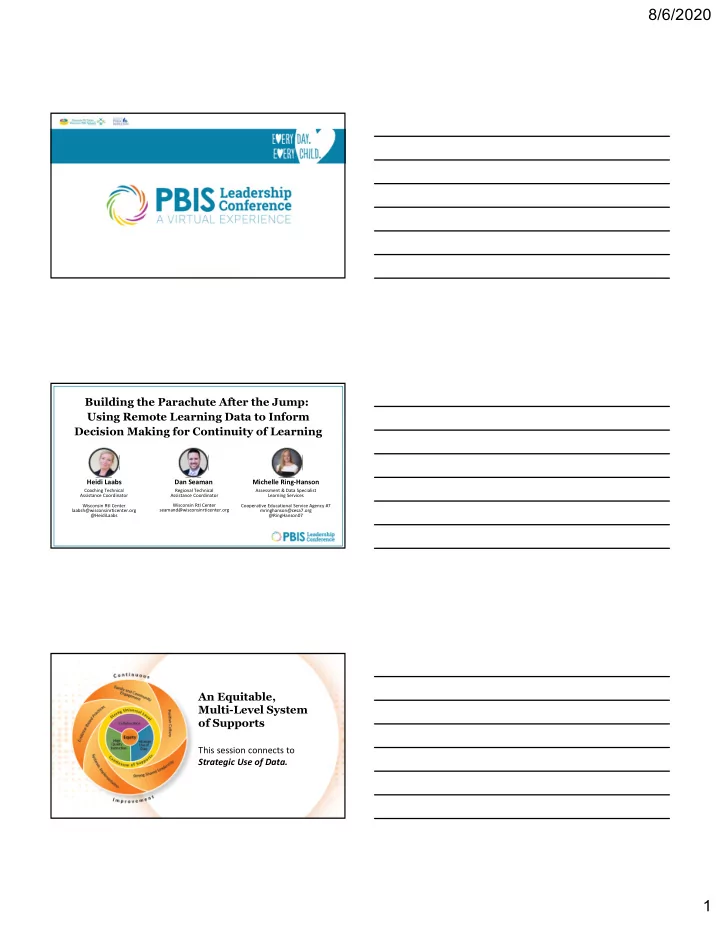

8/6/2020 Building the Parachute After the Jump: Using Remote Learning Data to Inform Decision Making for Continuity of Learning Heidi Laabs Dan Seaman Michelle Ring ‐ Hanson Coaching Technical Regional Technical Assessment & Data Specialist Assistance Coordinator Assistance Coordinator Learning Services Wisconsin RtI Center Wisconsin RtI Center Cooperative Educational Service Agency #7 seamand@wisconsinrticenter.org laabsh@wisconsinrticenter.org mringhanson@cesa7.org @HeidiLaabs @RingHanson07 An Equitable, Multi-Level System of Supports This session connects to Strategic Use of Data. 1
8/6/2020 Equity Connection If you see this icon on a slide, there is a specific connection to the key system feature of equity . Five Factors Resource If you see this icon on a slide, there is a specific connection to “Five Factors that Facilitate Sustained Implementation of a Culturally Responsive, Multi ‐ level System of Support in Wisconsin.” This resource can also be viewed on our website. Session Outcomes • Participants will consider the implications of data use in the current learning environment. • Participants will identify available data sources from the remote learning environment that can be used to inform decision making. • Participants will identify additional data sources necessary to support student learning needs going forward. Specific assessment line items connected to this session’s content: TFI: 1.10, 1.11, 1.12, 1.13, 1.14, 1.15, 2.3, 2.6, 2.11, 2.12, 2.13, 3.3, 3.14, 3.15, 3.17 SIR: 9, 10, 17, 18, 19, 21, 22, 23, 24, 25, 26, 27, 28, 29, 31, 32, 33, 34, 35, 36, 37, 39, 47, 58, 61 2
8/6/2020 Strategic Use of Data in an Equitable Multi-Level System of Supports “Ongoing, reflective, and collaborative analysis of implementation and outcomes data in a problem ‐ solving process to inform improvement and achieve equity.” • Teams use IMPLEMENTATION DATA • to gauge the extent practices are in place and used as intended • to guide action planning • Teams use multiple forms of aggregated and disaggregated STUDENT OUTCOME DATA to identify the effectiveness of system of supports for learners and families AND who is benefiting from and whose needs are underserved by the system. National Guidance (PBIS, SISEP, I-MTSS, NCIL, LLC) “Use data to inform decisions about (a) which students, families, and educators need which supports (screening); (b) continuing, adjusting, or fading supports for students, families, and educators (progress monitoring); (c) ensuring all students, families, and educators experience benefit (equitable outcomes); and (d) supports are being implemented with fidelity.” What are the Implications of Data Use in the Current Learning Environment? Three considerations: 1. We can’t rely on the traditional data sources we have previously used to drive continuous improvement and planning. 2. Local district screening data will be more important than ever to assess current levels of student learning and identify instructional starting points. 3. Obtain current data on student social and emotional learning to help students manage their emotions and navigate a changing educational environment. 3
8/6/2020 How do We Plan for Continuous Improvement? With districts shifting to remote learning and the pause in state testing, educators don’t have access to the same data they typically did when planning for a new school year! However, there are other sources of data to help inform improvement efforts. Data Then and Now What we HAD: What we HAVE: • State assessments • Evidence of learning from student work • Local spring assessments • Student participation and • System assessments (SIR,TFI) engagement data • Discipline data for the year • Curriculum and instruction data • Attendance data for the year • Student/Teacher/Family surveys • Informal observations of students • Attendance and discipline data up while learning until mid ‐ March Universal Screening Process • Use assessments that are closely connected to the curriculum and provide information to help students access priority grade ‐ level work. • Identify what experiences will be necessary for a student to be ready to learn on grade level with their peers. • Do not use these assessments to hold a student back from grade ‐ level learning. 4
8/6/2020 Make Family Connections to Gauge Social and Emotional Learning 1. Establish partnerships with families and students as soon as possible. 2. Utilize a conversation protocol to gather information about their students’ academic, social, and emotional learning. 3. As Karen Mapp states, “Three glows before a grow!” 4. Focus on equity with regard to family connections ( who has been contacted and who hasn’t responded ). For More Information on Social-Emotional Learning Skills Check out CASEL’s An Initial Guide to Leveraging the Power of Social and Emotional Learning What Data Sources Are Available From the Remote Learning Environment that Can Be Used to Inform Decision Making? Data to learn from: 1. Remote learning surveys 2. Remote learning curriculum gap analysis 5
8/6/2020 Utilize Family, Student, and Staff Surveys The University of Wisconsin ‐ Milwaukee has free anonymous surveys to document the experiences of students, caregivers, and educators regarding distance ‐ learning. https://uwm.edu/sreed/distance ‐ learning/ Remote Learning Curriculum Gap Analysis Steps in the process 1. Identify standards not taught and assessed during remote learning. 2. For each standard not taught and assessed, describe any learning experiences the students received. 3. For each standard not taught and assessed, determine if it is essential knowledge . 4. For each essential standard , identify lessons or units to integrate within the current grade level work. Example of remote learning curriculum gap analysis template for elementary grades 6
8/6/2020 Focus on Essential Knowledge • Don’t teach everything from 4th quarter at the beginning of a new school year! • Prioritize highest ‐ leverage learning • Develop interdisciplinary connections • Strategic instructional choices As challenging as the coming school year may be, students deserve a full year of new learning. (Council of Chief State School Officers, 2020) Final Thoughts 7
Recommend
More recommend